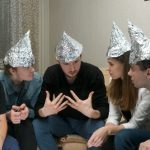 Weird Stuff
Weird Stuff  Weird Stuff
Weird Stuff  Mysteries
Mysteries 10 Tragic Disappearances and Deaths in Joshua Tree National Park
 History
History 10 Ways Childhood Really Sucked in the Old West
 Music
Music 10 Name Origins of Famous Bands from the 1990s
 Religion
Religion 10 Biggest Turnarounds by the Catholic Church
 Weird Stuff
Weird Stuff 10 Unbelievable Times Laws Had Unintended Consequences
 Humans
Humans Ten Historic Women Who Deserve Way More Credit Than They Got
 Movies and TV
Movies and TV 10 Films That Spawned Major Lawsuits
 History
History Ten Times Towns Were Wiped Off the Face of the Earth
 Creepy
Creepy 10 of the Most Disturbingly Haunted Public Houses in the UK
 Weird Stuff
Weird Stuff 10 Niche Subcultures That Are More Popular Than You Might Think
 Mysteries
Mysteries 10 Tragic Disappearances and Deaths in Joshua Tree National Park
 History
History 10 Ways Childhood Really Sucked in the Old West
Who's Behind Listverse?

Jamie Frater
Head Editor
Jamie founded Listverse due to an insatiable desire to share fascinating, obscure, and bizarre facts. He has been a guest speaker on numerous national radio and television stations and is a five time published author.
More About Us Music
Music 10 Name Origins of Famous Bands from the 1990s
 Religion
Religion 10 Biggest Turnarounds by the Catholic Church
 Weird Stuff
Weird Stuff 10 Unbelievable Times Laws Had Unintended Consequences
 Humans
Humans Ten Historic Women Who Deserve Way More Credit Than They Got
 Movies and TV
Movies and TV 10 Films That Spawned Major Lawsuits
 History
History Ten Times Towns Were Wiped Off the Face of the Earth
 Creepy
Creepy 10 of the Most Disturbingly Haunted Public Houses in the UK
10 Crazy Conspiracy Theories from Early American History
Conspiracies are not new. People have been worried about secret groups and powerful people for a long, long time. Many conspiracy theories have been around for thousands of years, in fact. And it’s been no different throughout the history of the United States. Even by the early 1800s, there were a lot of conspiracy theories spreading around in America.
This was because many political parties were competing for power. In some cases, the conspiracies dealt with big problems around slavery. But other baseless claims centered on more topics too. Even after the Civil War ended, many people across the country still believed in conspiracies. As you might expect, some of these theories were very strange.
Today, we’ll take a look at ten examples of bizarre and baseless conspiracy theories about American politics from the 19th century. Put your tin foil hats on and go back in time with us for these sketchy claims and unfounded allegations.
Related: Top 10 American Conspiracy Theories That Are Completely Bonkers
10 The Early Illuminati
In America, there have always been conspiracy theories about politics. A few years after the American Revolution ended in 1783, political parties started accusing each other of secret plans. This all began in the late 1700s. A minister named Jedidiah Morse from Massachusetts was a big part of the problem. He would give sermons saying that a group called the “Bavarian Illuminati” had infiltrated American society.
According to him, they supposedly wanted to overthrow the government and take down Christianity. Morse said that the Illuminati were like the Jacobins in France, who were closing churches and promoting atheism at the time. He also said the Illuminati wanted people to live poorly and not follow traditional values. Naturally, many conservative early Americans were horrified by this.
Morse even said that future president Thomas Jefferson and his political party were all part of this Illuminati. Morse was an active Federalist, which at the time was the political party diametrically opposed to Jefferson’s Democratic-Republican party. Slowly, other people began to believe Morse’s ideas, including prominent community leaders up and down the eastern seaboard.
As the 1800s began, people stopped talking about the conspiracy. But it never completely went away. Even now, some Americans still believe that the Illuminati is controlling things in a bad way. Of course, there is no real evidence to prove it. But that hasn’t stopped Americans from thinking something demonic is at work—back then or now![1]
9 The Know Nothing Party of Protestants
In the early 19th century, a group of American nativists formed a secret society. The group claimed itself to be of “pure” Anglo-Saxon heritage. They saw themselves as fighting for their rights against perceived American invaders who were mainly Catholics. This society was given the informal name of the “Know Nothing” group.
It was so-called because its members would claim ignorance about the existence of the group if they were ever questioned. Despite their secrecy, the party gained significant political power. Their main fear was that immigrants from Catholic countries were undermining American society. Quickly, Protestants across America were swept up in their fervor.
The Know Nothings and other nativist political groups believed the influx of Irish Catholic immigrants in the 1840s posed a threat to the young country. They propagated the idea that these Catholics were not true Americans. They held allegiance only to the pope, the party claimed. And the pontiff was supposedly said to be intent on destroying Protestant America. The group spread unfounded rumors of lurid crimes committed by Catholic representatives.
Many Catholic adherents were accused of murder and kidnapping, even despite the lack of evidence. As Protestants became more engaged with the group, the Know Nothings helped pass laws that restricted immigration and limited alcohol consumption. They made things very hard for new arrivals to participate in civic life and find jobs in the new land. Of course, arriving Catholics weren’t intent on destroying the U.S. But the Know Nothings cared not and continued their onslaught for years.[2]
8 The Order of the Star Spangled Banner
As the Know Nothing party emerged, it became more popular. Eventually, by the 1850s, it transitioned from a secret society into a fully-formed group known as the Order of United Americans. Later, that political set officially became the Order of the Star Spangled Banner. As it gained power and influence, it transformed into a full-blown political party by the end of the decade.
Many Know Nothings were elected to positions as governors and legislators across the country. Their belief that immigrants were a threat to the American way of life appealed to people in many locales. Not only were Irish Catholics targeted, but German immigrants and women’s suffragists were also seen as a danger. For a while, the Know Nothings looked as though they might continue to gain power.
However, the Know Nothings’ rise to power was built on fear and anger and not much else. The furious followers led forth destructive actions that included church burnings. In some cities, the formation of violent gangs was common. Men roamed the streets, looking to cause mayhem. But this was not a sustainable foundation. After a few years, the party eventually collapsed. The party’s avoidance of the issue of slavery also contributed to its downfall.
At the time, slavery was the biggest political issue in America, and the Know Nothings wanted little to do with it. Plus, people soon began to realize that the party’s ideal vision of a United States populated only by “pure” white Protestants was impossible to achieve. In time, the Know Nothings’ influence slowly waned. Soon, they became a forgotten and discarded conspiracy theory of the past.[3]
7 Soon, Slavery Conspiracy Theories Thrived
The years leading up to the American Civil War were marked by a proliferation of political conspiracies, particularly in the South. As the divide between North and South grew more pronounced, many Southerners became convinced that forces were working to undermine their way of life and abolish slavery.
Rumors were rampant that abolitionists were in league with the British government. They were supposedly intent on destroying American democracy and the economy. Others believed that powerful figures within the Republican Party were plotting to outlaw slavery and become known as “Black Republicans.”
These conspiracies were fueled by some (very, very small) bits of fact. Abraham Lincoln, a Republican, did indeed speak of the “ultimate extinction” of slavery in 1858. However, despite the Republican party’s efforts to limit the expansion of slavery, they did little to actively abolish the practice. This did not stop Southern leaders from using the specter of a Republican conspiracy to justify their calls for secession.
Mississippi senator William Harris wrote that his state “will never submit to the principles and policy of this black Republican administration.” Though these conspiracies were largely unfounded, they had a powerful impact on the events leading up to the Civil War. Soon, southerners of all stripes were angered at the supposed actions of the North—even though much of it hadn’t even truly been done.[4]
6 But Abolitionists Bought Conspiracy Talk Too
The issue of slavery in the United States was highly divisive and contentious, with both sides harboring deep suspicions about the other. Southern slave owners, who relied heavily on the institution of slavery for their economy and way of life, grew increasingly alarmed at the idea of outsiders actively working to dismantle their culture. But it’s important to note that slavery-related conspiracy theories didn’t just go one way.
On the other side of the issue, anti-slavery abolitionists also had their own suspicions. One was known as the “slave power” conspiracy. They alleged that slave owners had infiltrated all levels of government and were working to make their way of life the norm for all. In a way, it was very similar to the Bavarian Illuminati theory from earlier American history.
These suspicions and conspiracies helped to fuel the growing divide between the North and South. Many Northerners who were previously indifferent to slavery or held racist beliefs began to believe that the Southerners were indeed gaining too much power. Some even alleged that it went all the way to the top.
For the most radical, the president himself was thought to either be one of the conspiratorial southerners in secret, or else he was too weak to resist their influence. Though there was never any concrete evidence uncovered to support these suspicions, they served to unite many disparate groups in the buildup to the Civil War. Some scholars argue that these conspiracy theories even contributed to the rise of the Republican Party in the 19th century.[5]
5 Eventually, Conspiracy Led to Secession
In the early decades of the 19th century, American political conspiracies were often dismissed as far-fetched. However, as tensions over the issue of slavery escalated and states struggled to find a solution, these conspiracies began to gain traction. The final straw came on December 20, 1860, when South Carolina became the first state to secede from the Union.
This and subsequent secessions were sparked by the election of Republican Abraham Lincoln. However, a closer examination of the secession declarations reveals that conspiracies also played a role in the country’s breakup.
In its own declaration of secession, Texas claimed that the North had sent emissaries to wreak havoc in the state. These alleged misdeeds included undermining Southern culture, spreading fear and doubt among Southerners, poisoning water supplies, and committing arson in towns throughout the state. Other states made similar accusations.
They argued that Lincoln and his allies not only wanted to disrupt their way of life but to kill Southerners. Of course, in reality, Lincoln’s recorded desire was to reconcile with the South after the Civil War ended. He believed it so strongly that his allies would soon think he was being too lenient on Southerners. Thus, these conspiratorial claims seem highly unlikely. Nevertheless, they were part of the cause of the country’s violent and awful fracture.[6]
4 Slave Rebellions Became Conspiracy Hotbeds
In the 19th century, American slave owners were plagued by the fear of a slave rebellion. They knew their mistreated slaves were tired of their inhumane treatment. And they believed there was a real possibility that enslaved people would rise up and overthrow their masters.
This fear was not unfounded. After all, the Haitian Revolution of 1804 was fresh in slave owners’ minds. In that event, enslaved Haitian people successfully rebelled against their French masters. Then, they established the first country run by former slaves. For decades, it served as a reminder that similar events could happen on American soil.
The idea of a widespread slave rebellion was further fueled by conspiracy theories about the actions of abolitionists, as we’ve seen. The rebellion rumors also spread quickly after the failed attempt of John Brown to incite an armed uprising in Virginia in 1859. Despite the fact that Brown’s attack ultimately failed, many slave owners believed a large-scale rebellion was imminent.
Even after Brown’s execution, Southerners grumbled about a revolution from within. Some even went so far as to imagine vicious, well-organized slaves seeking bloody revenge. In turn, they mistreated their slaves even more, hastening the hatred within their ranks. Of course, the Emancipation Proclamation of 1863 and the subsequent history of the United States have shown that such a rebellion never came to fruition. But it didn’t stop slaveholders from forever fearing the worst.[7]
3 Lincoln’s Assassination Was Conspiracy Catnip
President Abraham Lincoln’s assassination on April 14, 1865, was a tragic event in many ways. For one, it marked a major turning point in American history. Of course, the president’s outing at Ford’s Theater that night ended in his murder by actor John Wilkes Booth. The thespian had assembled a small group of conspirators to first kidnap Lincoln. But things didn’t turn out that way.
As soon as Lincoln’s death was reported, there were suspicions that the plot was far beyond the abilities of some second-rate actor and his friends. Theories began to circulate almost immediately that the president’s demise was the work of a larger, more organized group of Southern rebels.
The list of potential masterminds behind the supposed plot included Confederate President Jefferson Davis and Confederate Secretary of State Judah P. Benjamin. Some people even went as far as to suggest that Benjamin—who was Jewish—was influenced by a larger network of anti-Lincoln European bankers. Other theories suggested the Catholics or Irish Americans may have been behind the assassination.
In that realm, the Know Nothings of the past rose up again for one more rumor. At the time, even Union officials were accused of being involved. Some insiders wondered if Northern men who weren’t keen on Lincoln’s soft approach to the former Confederacy were part of the plot.
However, none of these conspiracies were ever proven true. Instead, the consensus remains that the assassination was, in fact, the work of Booth and a few of his associates. Obviously, it changed American history forever.[8]
2 Later Conspiracies Even Fooled Presidents
While much of the conspiracy content of the 19th century centered on the Civil War and the lead-up to that fight, there were other issues at play, too. After the Civil War ended, Americans became no less conspiratorial. Sure, they may have focused on different topics after a while. Slavery was over and done with, after all. But rumors still ran rampant.
In the late 19th century, a conspiracy theory fooled even the president of the United States. The individuals involved believed they were doing it for a good reason, given that President James Garfield was dying. It all began with the events of his assassination.
On July 2, 1881, a man named Charles Guiteau shot President James Garfield at a train station. President Garfield’s doctor attempted to find the bullet lodged in his body. As was customary at the time, they dug around in the wound with unsterilized equipment and hands. The President lingered on for weeks after their exploratory surgery. Sadly, though, he died of a massive infection on September 19.
But before that, his doctors had been issuing cheerful reports to the newspapers. They claimed he was “sleeping sweetly” or that “his eyes have regained their old-time sparkle.” This was apparently an attempt to bolster the confidence of the American public. It even made Garfield himself more confident that he would live through the shooting.
Sadly, it was not to be. Eventually, even the doctors had to admit their lie when the President finally died. Their subsequent death announcement brought forth a new rash of conspiracies about just how sick Garfield had really been prior to his passing.[9]
1 One Final Conspiracy to End the 19th Century
As we’ve seen here, conspiracy theories can have severe consequences in the real world. They can work to incite wars and completely alienate entire groups of people. And in America, the Civil War and its aftermath were far from the only time baseless claims were used to divide people. One jarring example at the end of the 19th century came in the Chinese Exclusion Act of 1882.
The act was meant to restrict immigration for those coming from Chinese racial backgrounds. This act resulted from increasing worries that Chinese workers were a threat to society and the economy. Economic downturns, labor competition, and concerns about “racial purity” all contributed to the passage of the act.
Proponents of the act, such as San Francisco mayor James D. Phelan, alleged that Chinese immigrants were part of a larger force of people. Those masses, Phelan and others argued, would harm America through disease and erosion of the American way of life. Does it sound familiar to the Know Nothing conspiracists of a few decades before? Sadly, 1882’s discriminatory act did not come out of nowhere.
Instead, it was a culmination of years of prejudice and fear toward Chinese immigrants. And it made life significantly harder for Chinese people who were already desperately trying to survive in America. In that way, the act and its proponents serve even today as a valuable lesson in how conspiracy can be used to justify discriminatory policies.[10]








